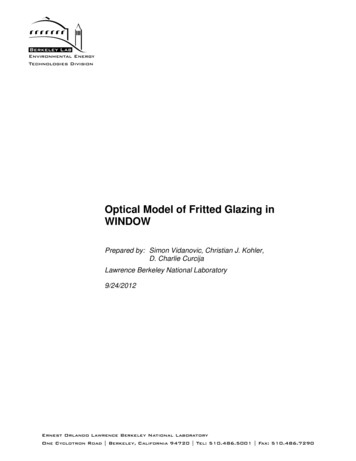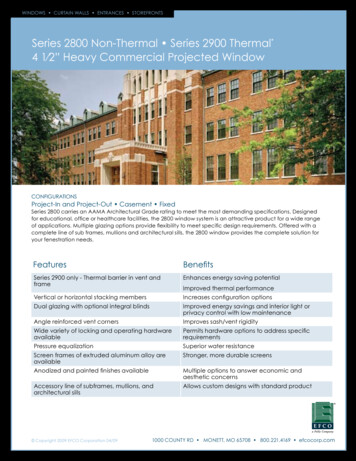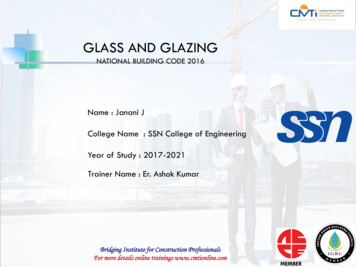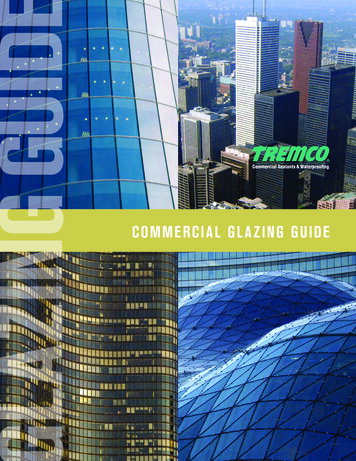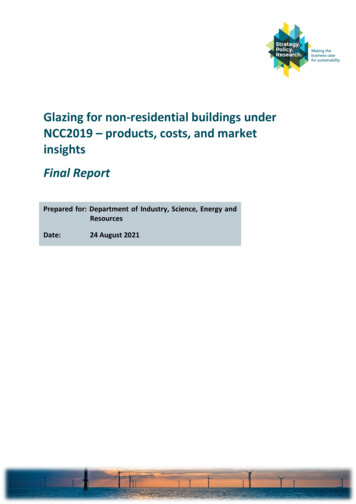
Transcription
Glazing for non-residential buildings underNCC2019 – products, costs, and marketinsightsFinal ReportPrepared for: Department of Industry, Science, Energy andResourcesDate:24 August 2021
Revision HistoryRevNo.DescriptionPrepared byReviewed byAuthorised byDate00Final 31/5/202101Final Report – rington27/7/202102Final Report – pHarrington3/8/202103Final Report – pHarrington16/8/202104Final gton24/8/2021 2021 Strategy. Policy. Research.This document is and shall remain the property of Strategy. Policy. Research. Pty Ltd. The document may only beused for the purposes for which it was commissioned and in accordance with the Terms of Engagement for thecommission. Unauthorised use of this document in any form is prohibited.SPR2024 Summary Final Reporti
Table of ContentsExecutive Summary . iii1.2.3.4.5.About this report. 21.1Purpose . 21.2Context . 2An overview of glazing market dynamics . 4Methodology. 73.1Analytical Method . 8Glazing Products and Costs – summary of findings . 124.1Complete Glazing Systems - Specifications and Costings. 124.2Cost and performance variations by Location, Product Type and Origin . 154.3System types – extent of variability . 174.4Industry expectations of change under NCC2019 . 19Glazing Practice, Product Trends, and Issues . 24Index of FiguresFigure 1: Roles and steps in the supply of Australian processed glazing products . 6Figure 2: Glazing research project - process summary . 7Index of TablesTable 1: Aluminium complete fixed frame systems - performance and costs . 12Table 2: Aluminium operating window frame systems - performance and cost . 13Table 3: Aluminium Door Systems - performance and costs . 14Table 4: Aluminium complete curtain wall systems . 15Table 5: Cost variations - factors by location . 16Table 6: Cost and performance variations for alternative product types. 16Table 7: Rules of thumb – local vs imported glazing systems . 17Table 8: WERS Rated Commercial Sector Product and Brand availability by frame material. 18SPR2024 Summary Final Reportii
Executive SummaryThis report contains the results of research into glazing products used in non-residential buildings.It has a particular focus on products likely to be used following energy performance requirementsin the National Construction Code (NCC) Volume 1, Section J. The current requirements wereintroduced in 2019 (NCC2019), with the next regulatory window for review and potential updatescheduled for 2025.The report identifies specifications, performance levels and prices for products typically used in nonresidential construction. These results are provided in section 4.1.Modelling and analysis for the development of requirements for NCC2025 draws particularly onresults for fixed frame windows. Table 1: Aluminium complete fixed frame systems - performanceand costs on page 12 contains this information. This report also provides insights into the marketand industry response to NCC2019.An important observation is that the glazing industry is well-positioned to supply products forbuildings designed to NCC2019. Standard aluminium double glazed frames using glass with relativelygood insulative properties (indicated by U-value) and good control of solar heat gain (indicated bySolar Heat Gain Co-efficient – SHGC) are readily available and will become more widely used.Similarly, thermally broken frames coupled with high performance glass are available and areexpected to achieve greater market penetration as buildings designed to NCC2019 are constructed.We find that improvement in glazing performance standards within the Australian constructionindustry is driven by Code changes. Innovation and investment tend to follow, rather than lead, theCode, as Code requirements have a major impact on the products and specifications demanded bythe market. This, in turn, has an important impact on the riskiness of, and return on investment on,innovation. Examples were provided to the research team whereby companies invested in highenergy-performance capacity in anticipation of Code changes, which then did not materialise,leading to that capacity sitting idle or under-utilised for many years.At the same time, the glazing industry has strong capacity to innovate when the Code and market issupportive of this. There is sufficient competition to ensure products are supplied at cost-effectiveprices.A common view in the glazing industry is that a lack of a rigorous Code compliance and enforcementimpacts negatively on the further development of the local glazing industry, particularly at the highperformance end of the market. The glazing industry supplies what its customers demand. If Codecompliance and enforcement is not rigorous, then below-specification glazing can be a profitablechoice for the construction industry. As a consequence, opportunities for growth of the local glazingindustry that would bring increased investment and employment are being foregone, while belowiii
specification glazing will contribute to unnecessarily high energy use and carbon emissions, alongwith reduced building occupant comfort and wellbeing.ii
1.About this report1.PurposeThe NCC, Volume 1, Section J deals with energy efficiency in commercial buildings.The next scheduled opportunity for updates to Section J is expected in 2025.In preparation, the Department of Industry, Science, Energy and Resources is managing a suite ofresearch and analysis projects for completion by mid-2021 to ensure inclusion in the ABCB workplan.A key area of Section J is glazing. Significant changes to the glazing requirements occurred underNCC2019. The 2019 settings were determined back in 2017. Since then, there have been shifts inbuilding designs, glazing product options, and glazing costs.This project examines the state of play in non-residential glazing products so that potential settingsfor the 2025 version of the Code (NCC2025) can be based on a sound understanding of productavailability and costs.A key task in the development of NCC2025 settings is cost-benefit analysis to assess the costeffectiveness of potential settings. This project will support the cost-benefit analysis with data oncommon specifications of products, and their costs, that are used in the construction of nonresidential buildings in Australia.The second purpose is to capture industry data and insights into glazing and construction practicesand trends related to glazing. This information will support development of the NCC and buildingspolicy more generally.1.1ContextGlazing is intrinsic to the functionality, as well as to the energy performance, of most building types.Retail, office, apartment, education, and health spaces all need glazing to provide visibility andnatural light. At the same time, glazing provides a ready pathway for heat and cold to pass in andout of buildings – particularly when compared to walls, floors, or other building elements. It can alsoadmit unwanted glare. Heating, ventilation, and cooling services then need to work harder tomaintain occupant comfort. This means that changing glazing specifications can be a very effectivestrategy to improve overall building energy performance – albeit that it is only one amongst many.The latest version of the energy efficiency requirements in the Code (Section J of NCC 2019) includedsignificant changes to thermal performance requirements for non-residential buildings, andspecifically for wall and glazing systems. The new approach recognises that the performance of thewhole wall system should be considered, including window-to-wall ratios, glazing U and Solar HeatGain Co-efficient (SHGC) values, thermal bridging and whole-of-wall system R-values for differentfaçade aspects, climate zones and building classes. At the same time, the intent was to simplify and2
address shortcomings in the previous glazing calculator used in NCC2016 and earlier versions of theCode.In addition to Code changes, the Australian and international markets for glazing products – andconstruction practices more generally – continue to evolve, impacting on energy performanceoutcomes and costs. In the short-to-medium term at least, the current coronavirus pandemic maybe having additional impacts on practices and costs.The department is keen to gather information on these issues to assist in its twin roles of providinginformation to all three levels of government related to buildings policy and informing the evolutionof the NCC.3
2.An overview of glazing market dynamicsThis section gives a brief overview of the elements of glazing systems and how the glazing industryin Australia combines to supply products for the construction market.2.1Glazing systems and componentsA glazing system is defined here as the windows, doors, or walls of buildings, which contain glass.The three main components of the glazing system are the glass; the framing material which holdsthe glass in place; and hardware – such as locks and handles.An example of a simple glazing system is a single glazed, fixed aluminium frame window. Thisproduct offers a high level of clarity and visibility, but limited performance on light control, solarheat control and thermal efficiency grounds.An example of a highly sophisticated glazing system is a double glazed, low-e, thermally brokenframed product. Here the glazing product serves several purposes - allowing light, visibility, andaccess to the building in a controlled thermal efficiency.Some of the main terms and components used by the glazing industry are defined below 1.U-value is a measure of the non-solar heat gain through the glazing system. The lower the U-value,the better the resistance to heat flow. U-values can be applied to glass only products (expressed asUg or Uglass) or whole glazing systems (expressed as Uw). This project restricted scope to whole-systemU-values.Solar Heat Gain Coefficient (SHGC) is a measure of the extent to which heat from direct sunlightflows. The lower the number, the less heat that is transmitted. SHGC can be applied to glass only orwhole-system products. Again, this project looked at whole system performance only – which is fullyexpressed as SHGCw.Visible Light Transmission (VLT) or Visible Transmittance (Tv) is the percentage of visible light thatpasses through the system. Lower numbers indicate less light transmittance.Float Glass is the glass sheets that are produced in the plant that combines raw materials (mainlysilica), melts them in a furnace, floats the molten glass onto a molten tin bath to form a sheet whichis then gradually cooled (annealed). It is also called annealed glass.Low-E Glass or low emissivity glass is float glass which has a thin metal coating on one side whichimproves the thermal and solar heat control properties of the glass.Tinted Glass is float glass with metal oxides added to produce tints such as blue, grey, bronze andgreen. Tinted glass can influence SHGC and VLT but not U-value.These definitions are drawn (approximately rather than precisely) from A Guide to Glass and Glazing: AHandbook to AS1288, Version 3, October 2017 published by the Australian Window Association (nowAustralian Glass and Window Association). We recommend this publication to those wanting more technicaldetail on glazing componentry and characteristics.14
Low-e hard coat glass (HC) is also called pyrolytic low e glass. It is a type of float glass where thesurface layer that gives the glass the improved U-value and SHGC is hard and fairly durable. It canbe used in single or double-glazed products as the coating can be exposed to air and cleaned.Low e soft coat glass (SC) is also called sputter coat glass. Sputter coatings are extremely thin layersthat offer substantial gains in U-value and allow low SHGC ratings while still admitting high levels ofvisible light. They are relatively fragile and not suitable for use in single glazed products. Soft coatsare used in double-glazed units with the sputter coating facing the inside of the unit, thus protected.DGUs are Double Glazed Units.IGUs are Insulated Glass Units – which can be double or triple glazed. The sheets of glass areseparated by a spacer and sealed. The gap can be filled with air, or argon gas is commonly used asthis improves U-value. IGUs provide superior U-value to a single-glazed unit. The U-value and SHGCof the IGU is then further influenced by the choice of glass.Frame – the support structure that surrounds the glass unit.Float glass plants produce float glass in clear, tints and low-e forms in a variety of thicknesses andwidths. There is just one plant in Australia. It can produce clear, tinted and low-e hard coated floatglass – but not low-e soft coats.Glass processors purchase float glass and process it into IGUs. They also strengthen and laminateglass to improve wind ratings and acoustic control. There are several processors in Australia whobuy a combination of locally produced and imported float glass.Aluminium extrusions are the lengths of aluminium extruded into lengths of particular shapes,ready to be cut and fabricated into frames.Fabricators take aluminium extrusions to make a frame, insert glass units and hardware to makethe complete glazing product. Fabricators can also use timber, uPVC or fibreglass as the framematerial instead of aluminium.Curtain walls are non-load bearing panels that can be used to make the façade of a building.Generally aluminium framing is used to surround glazed and non-glazed panels. Construction of stickbuild curtain walls occurs mainly on-site, with the wall being assembled piece by piece – or stick bystick. Unitised curtain walls combine large, one storey, units that include the frame, glazing andother panels. The units are assembled in a factory and then installed on-site. Unitised constructionis more efficient than stick build and allows faster on-site construction times. We understand thatstick build curtain walls are becoming rare in Australia. The curtain wall prices and specifications inTable 4 are for unitised curtain walls.2.1.1 Overview of the glazing supply industry in AustraliaThere is a multitude of firms with widely varying roles and sizes comprising Australia’s glazingindustry.A summary of the major steps and roles in the manufacture of glazing products is shown below:5
Float Glass ManufactureLocal by Oceania (sole Australian plant,formerly Viridian)ImportedGlass Processing - sizing, IGUs, strengthening, laminatesLocally using Oceania and imported glasses.Several local glass processorsImportedFraming material design & manufacture - aluminium dominatesAluminium - local extrusion designers &manufacturers or imported hardwareTimber, uPVC, fibreglass - locally made orimportedFinal glazing products - windows, doors, curtain wallsLocally fabricated to order using processedglass framing materials hardwareComplete products fully importedFigure 1: Roles and steps in the supply of Australian processed glazing products6
3.MethodologyClose collaboration with Australian Glass and Windows Association (AGWA) was a feature of thisproject. Both SPR and the department would like to express their gratitude to AGWA for theirproject guidance and assistance with member engagement.A summary of the project’s approach and method is illustrated in Figure 2, followed by furtherexplanation and detail.Engage & collaborate with industry- Establish a framework for data needs & collection- Gather information on market trends, practicesand dynamics through interviews with industryGather product specification and price datathrough a data collection spreadsheet distributedto industryAnalyse data and produce draft findings forreview/quality assurance by the department,AGWA and the wider construction industry- Finalise Report (SPR)- Publish Report (department)Figure 2: Glazing research project - process summaryThis project was designed to be highly collaborative from the outset. The department was aware ofthe need for industry input and gained AGWA’s agreement to participate prior to the commissioningof SPR as the research consultant. The department had also established potential informationpathways into the wider construction industry with support from the NSW Government’sDepartment of Planning, Industry and Environment, and the Better Buildings Partnership.Project inception established an informal project committee with members from the department,the NSW Government, AGWA and SPR. It was agreed that the key challenges were to:7
-Establish what information was required. Given the extensive variation in precise productspecifications, a method of narrowing focus onto more approximate product types wasrequired. Sufficient types were needed to provide a reasonable picture of common glazingproduct types and prices. Broader market information requirements also needed to bedefined.-Establish how to gather that information.SPR then worked with AGWA to develop a three-stage request to industry.Stage 1 was a call for interviews. AGWA kindly forwarded our request to their members. Requeststo the wider construction industry also went out via LinkedIn channels, NSW Government industrycontacts and industry groups such as the Better Buildings Partnership.Eleven glazing industry participants and two construction industry participants agreed to discuss the‘what and how’ of product specification and prices. The results reported in section 3 draw on theinformation provided in these interviews, especially the qualitative findings discussed in section 3.5.Industry also provided broader information on glazing market dynamics and trends – these arediscussed in sections 4 and 5.Stage 2 was a call to the glazing and construction industries to complete a data collectionspreadsheet, comprising a products specification matrix and a short questionnaire. The collecteddata is the basis of our findings in section 3.1 to 3.4.Both the interviews and spreadsheet data collection were conducted on a confidential basis. Thecontributors agreed to provide confidential data on the condition that it was de-identified and notlinked to any specific source. Several glazing industry participants provided data, and a singleconstruction/developer provided a small amount of information.The third stage was data verification. We provided interim performance and cost results to AGWAfor discussion with their members. The interim sheet was also provided to the Better BuildingsPartnership, NSW Government construction industry contacts and a small number of individualconstructors. AGWA provided feedback on behalf of their members. Unfortunately, no commentswere received from the wider construction industry.The department facilitated the sharing of cost and performance data from Tony Isaacs Consultingon glazing products used in residential buildings. This data was used to sense-check the nonresidential results rather than as a direct input into the analysis.The process of analysing the collected data is explained below.3.1Analytical MethodThe three main goals of the data collection and analysis were to:1) Identify commonly used glazing products – those that can be considered typical.8
2) Establish the energy efficiency performance of those products – with approximate U-Valuesand Solar Heat Gain Coefficients (SHGC).3) Establish the approximate cost per square metre of those products in different locations.The resulting list of products, performance levels and costs can be used to estimate the approximateglazing costs for widely ranging building designs in different climate zones.3.1.1 Identifying common productsIt is important to recognise that the research was not aiming to establish a full and precise pictureof all the glazing products used in Australian buildings.There is an almost infinite number of building design and glazing combinations that apply in theAustralian construction landscape. Non-residential building designs are unique, varying accordingto use, site, and regulatory requirements. Then there are a huge number of possible glazing options,with an abundance of choice in construction method, glass types and specification, framing types,size, etc.Accordingly, there are no standardised glazing systems (such as a complete window) for whichspecifications and prices are published on a catalogue.Instead, there is a many-step process of reaching the final product and price list. Many supplierspublish specifications of glazing product series (rather than complete units). These specificationsare for various combinations of glass and frame. The Windows Energy Rating Scheme (WERS)database contains 20,209 different product series that are registered and rated for use in thecommercial building sector. Each of those series can come in different sizes – so the total numberof final product options is huge.The wider construction industry (designers, energy efficiency and Ecologically Sustainable Design(ESD) consultants, builders, etc.) can select options from the suite of products. Typically, the optionsare developed on a project-by-project basis and refined with interaction between a few glazingsuppliers and the client, until a preferred set of solutions that best meets the building client’sperformance and price criteria is selected.The final set of specifications, sizes and prices are only known by the building client and thesuccessful glazing supplier.Given this situation, we asked industry to identify relatively common product types, where similarversions, with approximately equivalent specifications, are produced by many competing suppliers.The products are shown in section 4.3.1.2 Establishing performance levels related to energy efficiencyThe project focused on the two aspects of glazing product performance that play a role in the energyefficiency of a building.9
The U-values and SHGC measures cited in section 4 were provided by glazing industry sources, asrepresenting typical results for common glass types within fixed aluminium centre glazed frames.SPR then used a combination of other data provided direct by industry, WERS search results andadvertised product specifications to develop the approximate impact of different frame types on UValues and SHGC.Visible Light TransmissionThe U-value and SHGC of a glazing system affects Visible Light Transmission (VLT), another aspectof glazing performance. VLT can influence energy consumption as the use of natural light can reducethe use of electric internal lighting. This project reports glass only VLT measures, as VLT changessignificantly depending on frame type and size.Several glazing industry sources noted that it is important to understand the general relationshipbetween VLT and heat flows.In simple terms a lower SHGC necessitates a lower VLT – but this is not a fixed relationship. Highperformance double-glazed systems that use low-e sputter coated glass can achieve low U-valuesand SHGC while allowing high levels of light transmission. Low e hard coated glass can provide goodU-values and SHGC but VLT and clarity is not as well controlled as by their soft coat equivalents.Non-low-e tints control light and solar heat gain, but not U-value.SelectivitySelectivity or Light to Solar Gain (LSG) is a performance factor used in the US in the commercialglazing sector.Selectivity shows the relationship of SHGC and VLT through the LSG ratio with VLT divided by SHGC.Higher numbers indicate better performance – good transmission of light with low solar heat gain.Hard coat low-e products will generally have a LSG of below 1.25. Soft coat low e products will havea LSG of 1.25 up to 2.44.Given the benefits of combining good solar heat control performance with high levels of visible light,it would be useful for the LSG performance measure to become more widely used in Australia.Non-energy related glazing performanceOther aspects of glazing product performance include wind load resistance, impact resistance andacoustic performance.Broadly speaking, these areas of glazing performance are somewhat independent from U-value andSHGC.The thickness and use of laminated glass (sheets of glass joined with an interlayer) are the factorsthat influence strength and acoustic performance. Additional thickness adds strength, while theinterlayer (typically PVB – polyvinyl butyral) which bonds the glass sheets together also prevents10
shattering into large and sharp pieces. The PVB also improves acoustic performance – providing asound insulating effect.These thickness and laminating factors work separately to the hard coat or soft coat low-e coatingsthat are used to influence U-Value and SHGC.For example, two double-glazed systems using different glass thickness and laminate specifications,but the same low-e coatings will have very similar U-value and SHGC, but different strength andacoustic properties.Performance measurement - rating methodsThe U-values, SHGC and VLT scores shown in the report are results obtained under the WindowEnergy Rating Scheme (WERS). WERS is accredited by the Australian Fenestration Rating Council(AFRC) and follows the AFRC rating protocols. Those protocols largely follow the US system,developed by the National Fenestration Rating Council (NFRC) which is based on ISO15099.The NFRC/AFRC protocols are used in Australia, the US and Canada. However, in Europe, a differentset of glazing performance tests and rating protocols are followed. These deliver different U-valueand SHGC values for the same product. Generally speaking, the European system delivers lower Uvalues and higher SHGC than the AFRC system – therefore ratings produced under the differentsystems are not comparable.This issue is discussed further in section 5 as it is an ongoing issue of concern for the Australianglazing and construction market.3.1.3 Estimating CostsThe costs shown in the following section were estimated using a two-step process.The first step was to develop interim estimates using the various data provided by industry. We alsogathered data on the extent of discounts for large orders. Medium orders were roughly defined asthose worth a total of 100,000 to 500,000 delivered. Large orders are those with a value over 500,000. Small orders are under 100,000. We did not collect pricing on small orders as theyrepresent less than 20% of the total non-residential market.The interim version of costs and prices was then sent out to industry for review and feedback. Theresults are provided below.Note that we aimed to estimate a competitive price for a reasonable sized order of a typically usedproduct. This is not necessarily an average price. Smaller orders would come at a greater cost. Also,there is likely to be variability in pricing for some products as the market becomes accustomed toNCC2019. For instance, in some parts of Australia, such as QLD and WA where the market has notpreviously demanded large quantities of double-glazed products, average prices in those locationsmight lag behind the national competitive price point as the local industry tools-up for the shift inproduct demand.11
4.Glazing Products and Costs – summary of findingsThis section presents a summary of findings across the main areas of research.4.1Complete Glazing Systems - Specifications and CostingsThe four tables below show typical performance and prices for several generic frame types andconstruction methods.Table 1: Aluminium complete fixed frame systems - performance and costsFrame TypeGlazingUwSHGCwFixed single glazedSingle Glazed Clear6.10.75Fixed single glazedSingle Glazed Tint6.0Fixed single glazedSingle Glazed HC Low-E - ClearFixed single glazedVLTGlassOnly /sqm mediumorder /sqm e Glazed HC Low-E - Neutral4.20.4963230190Fixed single glazedSingle Glazed HC Low-E - Grey4.20.4340240195Fixed double glazedDouble Glazed Clear3.50.6480280240Fixed double glazedDouble Glazed Tint3.50.4240300265Fixed double glazedDouble Glazed SC Low-E - Clear2.50.5379310275Fixed double glazedDouble Glazed SC Low-E - Neutral2.40.2566360325Fixed double glazedDouble Glazed SC Low-E - Grey2.40.2139370335Fixed double glazedthermally brokenDouble Glazed Clear2.90.6480320270Fixed double glazedtherm
Johnston . Philip Harrington : Philip Harrington . 31/5/2021 : 01 . Final Report - WCAG revisions : Philip Harrington . Mark Johnston : Philip Harrington . 27/7/2021 : 02 . . Heating, ventilation, and cooling services then need to work harder to maintain occupant comfort. This means that changing glazing specifications can be a very effective
